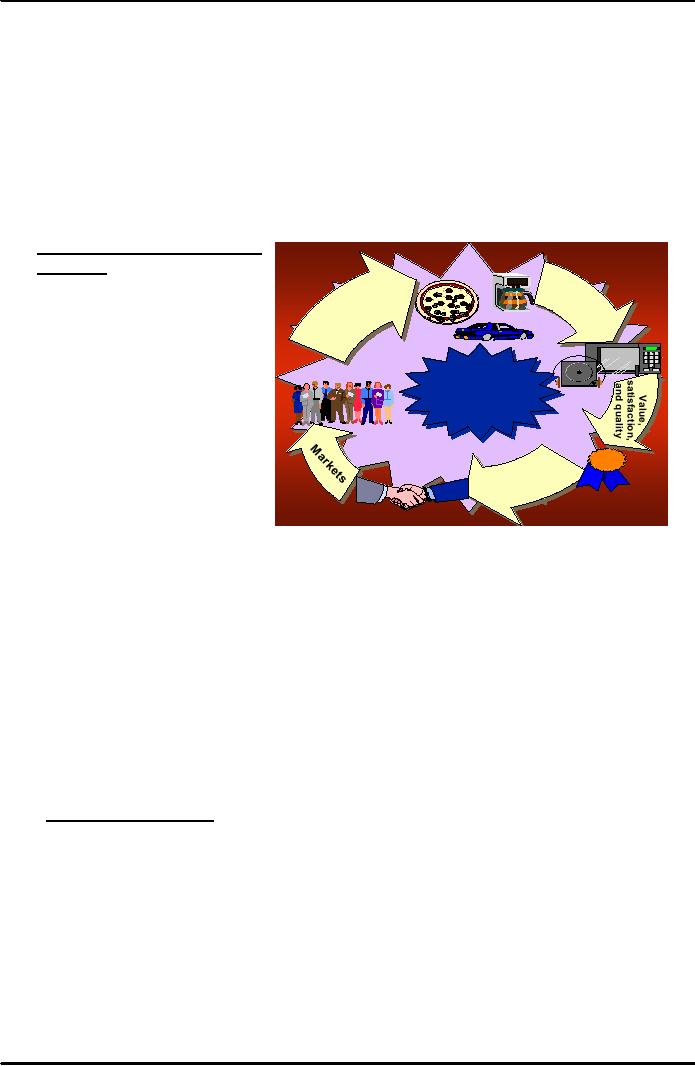 |
ROAD MAP:UNDERSTANDING MARKETING AND MARKETING PROCESS |
| << PRINCIPLES OF MARKETING:Introduction of Marketing, How is Marketing Done? |
| MARKETING FUNCTIONS:CUSTOMER RELATIONSHIP MANAGEMENT >> |

Principles
of Marketing MGT301
VU
Lesson
2
Lesson
overview and learning objectives:
In
last Lesson we tried to understand
the term of marketing its need
and its impact on the
organization.
The focus in this discussion
is to have concept of about different
core concepts of
the
marketing and the increasingly important
role of the marketing process in
the ever-changing
domestic
and global business environment
Today we will be covering
following topics:
A.
ROAD MAP
B.
UNDERSTANDING MARKETING AND MARKETING
PROCESS
C.
CORE MARKETING
CONCEPTS
Now
we will discuss these topics one by
one:
A.
Road Map
We
will cover following topics in
our coming Lessons:
·
Introduction-an
overview of marketing.
·
Understanding
Marketing and Marketing
Process
·
Marketing
Functions and Customer Relationship
Management
·
Marketing
in Historical perspective and
Evolution of Marketing
·
Marketing
Challenges in the 21st
century
·
Marketing
Management Process
·
Strategic
Planning and Marketing
Process
·
The
Marketing process
·
Marketing
Environment (Micro)
·
Marketing
Environment (Macro)
·
Analyzing
Marketing opportunities and developing
strategies-MIS
·
Marketing
Research
·
Consumer
Market-understanding the consumer
·
Consumer
Markets and consumer buying
behavior
·
Buying
Behaviors for New Products and
services
·
Business
Buying Behavior
·
Market
segmentation
·
Developing
the Marketing Mix--- 4
P's
·
Product
Planning
·
Service
Strategy
·
Pricing
·
Pricing
Strategies
·
Price
Adjustment and Price
Changes
·
Distribution
Channels
·
Logistics
Management
·
Retailing
and wholesaling
·
Promotion
Planning
·
Advertising
5

Principles
of Marketing MGT301
VU
·
Public
Relations
·
Personal
Selling
·
Sales
Promotion
·
Sales
Force Management
·
Integrating
and analyzing the marketing
plan
·
Global
Marketing
·
Technological
developments and Marketing
·
Web
base Marketing
·
Social
Marketing
·
Social,
Ethical and Consumer
issues
·
Review
·
Marketing
in a Glance
B.
Understanding Marketing and Marketing
Process
Process
by which individuals and groups
obtain what they need
and want through creating
and
exchanging
products and value with
others is termed as marketing process.
The marketing process
consists
of four steps: analyzing market
opportunities; developing marketing strategies;
planning
marketing
programs, which entails choosing
the marketing mix (the four
Ps of product, price,
place,
and promotion); and organizing,
implementing, and controlling
the marketing effort.
Marketing
is the organizational function charged
with defining customer
targets and the best
way
to
satisfy needs and wants
competitively and profitably.
Since consumers and business
buyers face
an
abundance of suppliers seeking to
satisfy their every need,
companies and
nonprofit
organizations
cannot survive today by simply
doing a good job. They
must do an excellent job
if
they
are to remain in the increasingly
competitive global marketplace. Many
studies have
demonstrated
that the key to profitable
performance is to know and
satisfy target customers
with
competitively
superior offers. This process
takes place today in an increasingly global,
technical,
and
competitive environment.
The
concept of markets brings one full circle to
the concept of marketing.
1).
Sellers must search
for buyers,
Actors
and Forces in a
identify
their needs, design good
products and
Modern
Marketing System
services,
set prices for them,
promote them,
and
store and deliver
them.
Environment
2).
A
modern marketing system
includes
all of the elements
necessary to bring
buyers
and sellers together.
This might
include
such
activities
as
product
Company
(marketer)
development,
research,
communication,
Marketing
End-user
distribution,
pricing, and service.
inter-
Suppliers
market
mediaries
3).
Each of the major actors in
a
marketing
system adds value for the
next level
Competitors
of
the system.
There
is often critical
interdependency
among network
members.
There
are certain factors that can
influence the marketing process
directly or indirectly termed
as,
"actors
and forces in marketing system". Let's
have brief explanation of
these actors and
forces:
Company
or
Marketing
Organization -marketing
plans must accommodate the
needs of other
functional
areas of the firm to coordinate
product/service delivery
effectively.
Suppliers
- are
the firms and persons
that provide the resources
needed by the company
and
competitors
to produce goods and
services.
6

Principles
of Marketing MGT301
VU
Marketing
Intermediaries - include
various middlemen and distribution
firms as well as
marketing
service agencies and
financial institutions.
Customers
-usually
consist of consumer, industrial,
reseller, government, and
international
markets.
Competitors
- are
usually considered those companies
also serving a target market with
similar
products
and services, although
broader definitions may
apply.
Publics
- may
consist of any group that
perceives itself having an interest in
the actions of the
firm.
Publics can have positive as well as
negative influences on the company's
objectives.
Other
than factors above there are
certain macro environmental factors that
can have impact or
that
can affect the marketing
process. These forces and
environmental factors will be
discussed in
more
detail in coming Lessons. As
described in a fig: important
connections with customers,
connections
with marketing partners, and connections
with the World around us
are to be made in
order
to perform the marketing process.
The main connections required in
this regard are
connecting
with marketing partners: (These
connections occur by (a)
connecting with other
marketing
departments, (b) connecting with
suppliers and distributors,
and (c) connecting
through
strategic
alliances). Marketing companies do
not operate in a vacuum.
They have to be
interacting
with
intermediaries that have
information to share, ideas to explore,
and experiences that
are
invaluable.
New technologies can bring
this information to the
decision maker in new rapid
ways.
Finally
companies need to have
information about the
competitors and other
environmental
factors
and are need to have
updated knowledge because for
success, change adoption
with change
occurrence
is required otherwise company will not
able to stay in this
completive era.
What
image comes to mind when
you hear the word
"marketing"? Some people
think of
advertisements
or brochures, while others
think of public relations (for
instance, arranging for
clients
to appear on TV talk shows). The
truth is, all of these--and
many more things--make
up
the
field of marketing because as we have
discussed in our last Lesson
that marketing is more
than
just
advertisement or promotion. The Knowledge
Exchange Business Encyclopedia defines
marketing as
"planning
and executing the strategy
involved in moving a good or
service from producer
to
consumer."
With
this definition in mind,
it's apparent that marketing
and many other business
activities are
related
in some ways. In simplified terms,
marketers and others help
move goods and
services
through
the creation and production
process; at that point,
marketers help move the
goods and
services
to consumers. But the connection
goes even further: Marketing
can have a
significant
impact
on all areas of the business
and vice versa. Lets
have discussion on some
basics of
marketing:
(already mentioned in first
Lesson:
(first
the four P's, and
then the six P's)
·
Product--What
are you selling? (It
might
Price
Product
be
a product or a service.)
·
Price--What
is your pricing
strategy?
·
Place
or distribution--How are
you
distributing
your product to get it
into
Customers
the
marketplace?
·
Promotion--How
are you
telling
consumers
in your target group
about
Place
Promotion
your
product?
7

Principles
of Marketing MGT301
VU
·
Positioning--What
place do you want your
product to hold in the consumer's
mind?
·
Personal
relationships--How are you
building relationships with your
target consumers? So
based
upon all this discussion
marketing process can be defined as a
social and managerial
process
by which individuals and groups
obtain what they need
and want through
creating,
offering
and exchanging products of value with
others
The
sum of the above is called
the marketing mix. It is important to
have as varied a mix
as
possible
in marketing efforts, since each
piece plays a vital role
and boosts the overall
impact.
Let's
take a closer look at the
basic P's of marketing and
particularly at how they
might affect what
you
do in business.
Product
Marketers
identify a consumer need and
then provide the product or
service to fill that need.
The
marketer's
job is to pinpoint and understand
existing needs, expand upon them,
and identify new
ones.
For example, because there
are more singles and small
families these days than in
years past,
marketers
might see a need for
products to be sold in smaller quantities and
offered in smaller
packages.
How
can this impact other
professionals in the business/marketing
process? Let's say
your
company
has developed a new product
that generates enormous consumer
demand. Your
marketing
department may ask you to
find a way to speed up the
workflow in order to crank
out
more
products faster. A year after
the product is introduced,
however, the market might
be
flooded
with cheap imitations. Since
one marketing strategy is to keep
products price-competitive,
a
marketer may then ask you to
find a way to make the
product less expensively.
This
relationship works both
ways. There may be
production and industrial
engineers who may see
a
way to change the work
process that would create
additional options for consumers.
Those
engineers
will also be instrumental in
design and development of
products for which
human
factors
and ergonomics are important
considerations. Maybe there's room to add
another product
line.
For instance, that product X
is still blue but new
product Y is red. You can
suggest this to
your
marketing department; it, in turn, would
do research to gauge potential consumer
demand for
the
new line.
Price
Ideally,
a marketer wants to be proactive in setting price
rather than simply react to
the
marketplace.
To that end, the marketer
researches the market and
competition and plots
possible
price
points, looking for gaps
that indicate opportunities.
When introducing a new
product, the
marketer
needs to be sure that the
price is competitive with
that of similar products or, if
the price
is
higher, that the consumers
perceive they're getting more value
for their money.
Various
other technical professionals can
have an important impact on marketers'
pricing
decisions.
Again, you may be asked to determine if
productivity can be enhanced so
that the
product
can be manufactured and then
sold--for a lower
price.
Place
or distribution
What
good is a product if you
can't get it to people who
want to purchase it? When
marketers
tackle
this issue, they try to
figure out what the
optimum distribution channels would
be. For
example,
should the company sell
the product to distributors
who then wholesale it to
retailers or
should
the company have its own
direct sales force?
Marketers
also look at where the
product is placed geographically. Is it sold
regionally, nationally,
and
internationally? Will the
product be sold only in high-end
stores or strictly to discounters?
The
answers
to all of these questions
also help shape how a
product can be distributed in
the best way.
8

Principles
of Marketing MGT301
VU
Such
distribution questions are
potentially of great significance to
many professionals,
including
industrial
and other types of engineers
in a company. For instance,
whether a product will
be
marketed
regionally or internationally can
have enormous implications
for package design as
well
as
obvious areas of the supply
chain: logistics, transportation,
distribution, and warehousing.
Promotion
Promotion
encompasses the various ways
marketers get the word
out about a
product--most
notably
through sales promotions, advertising,
and public relations.
Sales
promotions are special
offers designed to entice
people to purchase a product.
These can
include
coupons, rebate offers, two-for-one
deals, free samples, and
contests.
Advertising
encompasses paid messages
that are intended to get
people to notice a product.
This
can
include magazine ads, billboards, TV
and radio commercials, Web
site ads, and so
forth.
Perhaps
the most important factor in
advertising success is repetition. We're
all bombarded with
an
enormous number of media
messages every day, so the first
few times a prospective customer
sees
an ad, it usually barely makes a
dent. Seeing the ad over
and over is what burns
the message
into
people's minds. That's why
it's good to run ads as
frequently as possible.
Public
relations refer to any non-paid
communication designed to plant a
positive image of a
company
or product in consumers' minds. One way
to accomplish this is by getting the
company
or
product name in the news.
This is known as media relations,
and it's an important aspect
of
public
relations.
As
with price, changes in
demand created by promotions
can have a direct impact on the
work of
many
other professionals.
Positioning
By
employing market research techniques and
competitive analysis, the marketer
identifies how the
product
should be positioned in the consumer's
mind. As a luxury, high-end
item? A bargain item
that
clearly provides value? A fun product? Is
there a strong brand name
that supports how
the
image
is fixed in the consumer's mind? Once
the marketer answers these
kinds of questions, he or
she
develops, through a host of
vehicles, the right image to
establish the desired
position.
This,
too, can affect the
work you do. If an upscale
image is wanted, the materials
used in the
product
and packaging are likely to
be different from those used in a
bargain product--a fact
that
could
make the workflow
significantly more complex. On
the other hand, with
your engineering
knowledge,
you may be able to suggest
alternative materials that would
preserve the desired
image
but
be easier or less expensive to
use.
Personal
Relationships
In
recent years, personal relationships have
come to the forefront of
marketing programs.
Now
even
the largest companies want
their customers to feel that they
have a personal relationship
with
the
company. Companies do this in
two ways: They tailor
their products as much as
possible to
individual
specifications, and they
measure customer satisfaction.
The
firm's contribution can
significantly impact the area of
personal relationships. If the
work
processes
the firm creates cannot
meet the customer time
frames, the relationship
will be damaged.
If
the firm develops
manufacturing lines that
cannot be tailored to fit individual
customer needs, it
will
be difficult for the company
to give consumers the perception of
personal commitment. If
salespeople
promise delivery by a certain date, but
the product cannot be produced on
schedule,
consumers
will not be happy.
9

Principles
of Marketing MGT301
VU
Marketing,
engineering, and many other
professional activities are interrelated and
interdependent
disciplines.
By understanding the role
that marketers play in moving a
good or service to
consumers,
others can operate more
effectively, for the present
and the future.
C.
Core Marketing
Concepts
To
have more clear view
about the marketing and to understand
the marketing process first
we
should
discuss the some basic
concepts, which we will be
discussing in the coming
Lessons and
what
is the main essence of the
marketing process and we can
say that the marketing
revolves
around
theses concepts.
a.
Needs,
wants,
and
demandsNeeds
Human
,
Pr
needs
are the most basic
concept
nts
s
od
u
wa
Se
and cts
s,
and
underlying
marketing. A human need
rvi
ed
m
ce
Ne
d de
s
is
a state of felt
deprivation.
an
1).
Humans
have many complex
needs.
Corre
Co
e
a).
Basic,
physical needs for
Markettiing
Marke
ng
food,
clothing, warmth, and
Conceptts
Concep
s
safety.
b).
Social
needs for belonging
and
affection.
Exchange,
transactions,
c).
Individual
needs
for
and
relationships
knowledge
and
self-
expression.
2).
These
needs are part of the
basic human makeup.
Wants
A
human want
is the
form that a human need
takes as shaped by culture
and individual
personality.
Demands
are
human wants that are backed
by buying power.
1).
Consumers view products as bundles of
benefits and choose products
that give them
the
best bundle for their
money.
2).
People demand products with
the benefits that add up to
the most satisfaction.
Outstanding
marketing companies go to great lengths
to learn about and understand
their
customer's
needs, wants, and demands.
The outstanding company strives to
stay close to the
customer.
b.
Products and
Services
A
product
is
anything that can be offered
to a market to satisfy a need or
want.
A
service
is an
activity or benefit offered
for sale that is essentially
intangible and does not
result
in
the ownership of
anything.
1).
The concept of product is not
limited to physical objects and
can include
experiences,
persons,
places, organizations, information, and
ideas.
2).
Be careful of paying attention to
the product and not
the benefit being
satisfied.
3).
"Marketing
myopia" is caused by shortsightedness or
losing sight of
underlying
customer needs by only focusing on
existing wants.
10

Principles
of Marketing MGT301
VU
c.
Value, satisfaction, and
quality
Customer
value is the
difference between the values
that the customer gains from
owning and
using
a product and the costs of
obtaining the product.
Customers do not often judge
product
values
and costs accurately or
objectively--they act on perceived
value.
Customer
satisfaction depends
on a product's perceived performance
in
Delivering
value relative to a buyer's expectations. If performance
exceeds expectations, the
buyer
is
delighted (certainly a worthy goal of
the marketing
company).
1).
Smart companies aim to
delight customers by promising only
what they can deliver,
then
delivering
more than they
promise.
2).
The aim of successful
companies today is total customer
satisfaction.
3).
Customer delight creates an emotional
affinity for a product or
service, not just a
rational
preference, and this creates
high customer loyalty.
4).
Quality has a direct impact on product or
service performance. Quality is defined
in
terms
of customer satisfaction.
The
term total quality management
(TQM) is an
approach in which all
the
company's
people are involved in
constantly improving the
quality of products,
services,
and marketing processes.
1).
In the narrowest sense,
quality can be defined as "freedom
from defects."
2).
Quality has a direct impact on product or
service performance. Quality is
defined
in terms of customer satisfaction.
3).
The fundamental aim of today's
total quality movement has
become total
customer
satisfaction.
d.
Exchange, transactions, And
relationships
Marketing
occurs when people decide to
satisfy needs and wants
through exchange.
Exchange
is the
act of obtaining a desired
object from someone by
offering something in
return.
Exchange
is only one of many ways to
obtain a desired object. Exchange is
the core concept of
marketing.
Conditions of exchange
include:
1.
At least two parties must
participate.
2.
Each must have something of value to
the other.
3.
Each must want to deal with
the other party.
Each
must be free to accept or reject the
other's offer
Whereas
exchange is a core concept of marketing, a
transaction
(a
trade of values between
two
parties)
is marketing's unit of measurement. Most
involve money, a response,
and action.
Transaction
marketing is part of a larger idea of
relationship
marketing. Beyond
creating short-
term
transactions, marketers need to build
long- term relationships with valued
customers,
distributors,
dealers, and suppliers.
Ultimately, a company wants to build a
unique company asset
called
a marketing
network
(the company and all its
supporting stakeholders). The
goal of
relationship
marketing is to deliver long-term value to
the customer and
thereby
secure
customer
satisfaction and retention of
patronage.
1).
Competition is increasingly between
networks.
2).
Build a good network of relationships
with key stakeholders and
profits will follow.
e.
Markets
The
concepts of exchange and relationships
lead to the concept of a market. A
market
is
the
set of actual and potential
buyers of a product.
11

Principles
of Marketing MGT301
VU
1).
Originally a market was a place where
buyers and sellers gathered to
exchange goods
(such
as a village square).
2).
Economists use the term to
designate a collection of buyers and
sellers who transact in a
particular
product class (as in the
housing market).
3).
Marketers see buyers as constituting a market and
sellers constituting an
industry.
4).
Modern economies operate on
the principle of division of
labor, where each person
specializes
in producing something, receives payment,
and buys needed things with
this money.
Thus,
modern economies abound in
markets.
5).
Marketers are keenly interested in
markets.
12
Table of Contents:
- PRINCIPLES OF MARKETING:Introduction of Marketing, How is Marketing Done?
- ROAD MAP:UNDERSTANDING MARKETING AND MARKETING PROCESS
- MARKETING FUNCTIONS:CUSTOMER RELATIONSHIP MANAGEMENT
- MARKETING IN HISTORICAL PERSPECTIVE AND EVOLUTION OF MARKETING:End of the Mass Market
- MARKETING CHALLENGES IN THE 21st CENTURY:Connections with Customers
- STRATEGIC PLANNING AND MARKETING PROCESS:Setting Company Objectives and Goals
- PORTFOLIO ANALYSIS:MARKETING PROCESS,Marketing Strategy Planning Process
- MARKETING PROCESS:Analyzing marketing opportunities, Contents of Marketing Plan
- MARKETING ENVIRONMENT:The Company’s Microenvironment, Customers
- MARKETING MACRO ENVIRONMENT:Demographic Environment, Cultural Environment
- ANALYZING MARKETING OPPORTUNITIES AND DEVELOPING STRATEGIES:MIS, Marketing Research
- THE MARKETING RESEARCH PROCESS:Developing the Research Plan, Research Approaches
- THE MARKETING RESEARCH PROCESS (Continued):CONSUMER MARKET
- CONSUMER BUYING BEHAVIOR:Model of consumer behavior, Cultural Factors
- CONSUMER BUYING BEHAVIOR (CONTINUED):Personal Factors, Psychological Factors
- BUSINESS MARKETS AND BUYING BEHAVIOR:Market structure and demand
- MARKET SEGMENTATION:Steps in Target Marketing, Mass Marketing
- MARKET SEGMENTATION (CONTINUED):Market Targeting, How Many Differences to Promote
- Product:Marketing Mix, Levels of Product and Services, Consumer Products
- PRODUCT:Individual product decisions, Product Attributes, Branding
- PRODUCT:NEW PRODUCT DEVELOPMENT PROCESS, Idea generation, Test Marketing
- NEW PRODUCT DEVELOPMENT:PRODUCT LIFE- CYCLE STAGES AND STRATEGIES
- KEY TERMS:New-product development, Idea generation, Product development
- Price the 2nd P of Marketing Mix:Marketing Objectives, Costs, The Market and Demand
- PRICE THE 2ND P OF MARKETING MIX:General Pricing Approaches, Fixed Cost
- PRICE THE 2ND P OF MARKETING MIX:Discount and Allowance Pricing, Segmented Pricing
- PRICE THE 2ND P OF MARKETING MIX:Price Changes, Initiating Price Increases
- PLACE- THE 3RD P OF MARKETING MIX:Marketing Channel, Channel Behavior
- LOGISTIC MANAGEMENT:Push Versus Pull Strategy, Goals of the Logistics System
- RETAILING AND WHOLESALING:Customer Service, Product Line, Discount Stores
- KEY TERMS:Distribution channel, Franchise organization, Distribution center
- PROMOTION THE 4TH P OF MARKETING MIX:Integrated Marketing Communications
- ADVERTISING:The Five M’s of Advertising, Advertising decisions
- ADVERTISING:SALES PROMOTION, Evaluating Advertising, Sales Promotion
- PERSONAL SELLING:The Role of the Sales Force, Builds Relationships
- SALES FORCE MANAGEMENT:Managing the Sales Force, Compensating Salespeople
- SALES FORCE MANAGEMENT:DIRECT MARKETING, Forms of Direct Marketing
- DIRECT MARKETING:PUBLIC RELATIONS, Major Public Relations Decisions
- KEY TERMS:Public relations, Advertising, Catalog Marketing
- CREATING COMPETITIVE ADVANTAGE:Competitor Analysis, Competitive Strategies
- GLOBAL MARKETING:International Trade System, Economic Environment
- E-MARKETING:Internet Marketing, Electronic Commerce, Basic-Forms
- MARKETING AND SOCIETY:Social Criticisms of Marketing, Marketing Ethics
- MARKETING:BCG MATRIX, CONSUMER BEHAVIOR, PRODUCT AND SERVICES
- A NEW PRODUCT DEVELOPMENT:PRICING STRATEGIES, GLOBAL MARKET PLACE